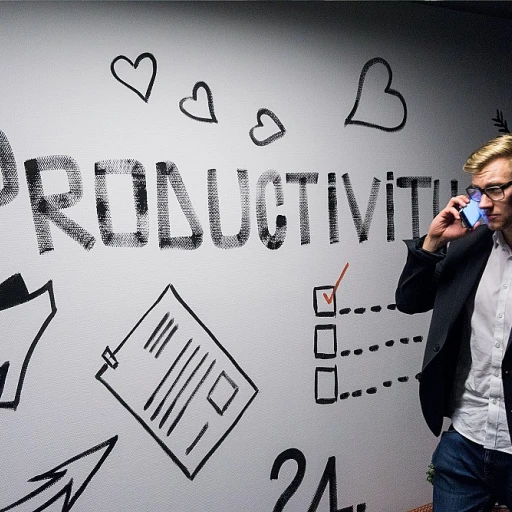Understanding the Role of Communication in Performance Feedback
The Core of Feedback Communication in Performance
Performance feedback—it's not just about ticking a box in a review cycle. Communication is at its core, shaping how employee performance evolves. The right feedback cultivates growth, nurtures skills, and drives improvement. It's clear: feedback forms a cornerstone of effective communication in your company. Having open lines with your employees ensures they're engaged and motivated to reach organizational goals. Feeling valued, employees are likely to invest in their work environment, knowing their input is acknowledged by managers. Human resources professionals emphasize feedback as a tool for continuous improvement. It's a blend of communication skills and emotional intelligence that helps managers coach their team members through the performance management process. A manager's role isn't a walk in the park—it's about balancing praise and constructive feedback. It's knowing when to praise time management efforts or suggest areas for improvement, ensuring the employee feels supported rather than criticized. In this dance of feedback, active listening is your best partner. Listen more than you speak, acknowledge employee perspectives, and respond with empathy. This not only enhances the effectiveness of your feedback but boosts employee engagement, creating a positive work ambiance where teams flourish. Eager to learn more on mastering this art? Don’t miss our article on mastering HR communication in performance reviews here. You'll uncover practical steps to refine your feedback strategy, uplifting employee performance to a new level.Preparing for Performance Feedback Sessions
Getting Ready to Chat Performance
Feedback, as effective communication, is more of a dialogue - not a monologue. Before stepping into a room with your employee, take the time to plan. Preparation not only boosts confidence but also sets a clear path for the session. Start by gathering insights about the employee's performance. Look at past reviews, set goals, and current performance metrics. This research provides context and allows you to focus on areas improvement. Review phrases should be clear and precise, leaving no room for ambiguity. Craft a balanced agenda that fuels constructive feedback and positive comments. Remember, the objective is to help the employee improve and feel motivated. So, mix performance analysis with positive feedback that acknowledges their strengths.Cues for Positive and Constructive Feedback
When you're all prepped, it's time to bring your communication skills to the table. Encourage an atmosphere where employees feel comfy to engage. Start the discussion with praise, and slip in performance-related suggestions as you go.- Be Precise: Use specific examples to illustrate points. If the employee needs improvement in time management, cite instances where delays affected team work.
- Positive Tone: Coupled with the right review phrases, maintain a confident yet considerate tone. Mention what they've aced before touching on what's more to improve.
- Active Listening: Listening is half the battle. Encourage a two-way conversation by asking questions and paying attention to their responses.
Breaking Down Communication Barriers
Barriers pop up out of nowhere in feedback conversations. Miscommunication, defensiveness, and power dynamics can throw a wrench in your efforts. To tackle these:- Body Language: Your posture speaks volumes. Relax, maintain eye contact, and nod occasionally. It shows you're attentive.
- Language Choice: Rid your speech of jargon. Stick to simple and relatable terms that prompt understanding.
- Regular Check-ins: Building a rapport beforehand by holding regular team check-ins reduces anxiety around performance reviews.
Best Practices for Delivering Constructive Feedback
Delivering Feedback That Sticks
Sharing feedback with your team can be a game-changer, not just an obligation on your list. Here’s how managers can make that moment count and truly make an impact on employee performance. First off, clarity is crucial. When you’re clear, employees feel valued. Use precise language, avoid any jargon, and ensure that your message is digestible. Think of it this way: crystal-clear feedback opens the door to continuous improvement. Being consistent is another feather in your cap. Regular performance reviews, instead of the once-a-year monologue, help create an environment where employees and managers can frequently connect. This rhythm fosters trust, making any constructive feedback easier to swallow and digest. Now, onto creating a comfortable space. Picture a relaxed setting—whether it’s over a coffee, a casual one-on-one, or a dedicated meeting. Putting team members at ease during performance conversations makes them receptive and willing to collaborate on areas of improvement. Don’t underestimate the power of the sandwich technique. Wrap negative input between layers of positive feedback. Complement effective communication by highlighting accomplishments before addressing areas improvement, and conclude with a positive note on potential growth. Active listening is a superpower that every manager should wield. Engage with your team by truly hearing what they have to say. This practice goes a long way in enhancing employee engagement and fosters open dialogues. Lastly, back up your points with solid examples. Instead of vague assertions, provide specific instances to illustrate your feedback. It’s like snapping a picture—everyone likes to see proof. For an in-depth look at maintaining effective HR communication throughout the entire performance review process, check out our detailed guide on mastering HR communication in performance reviews. When feedback is this effective, it’s as if you’ve struck gold in performance management! Team members walk away feeling equipped to tackle their work head-on, leading to a productive and harmonious work environment.Overcoming Common Communication Barriers
Breaking Down Barriers in Feedback Communication
To deliver effective feedback and boost employee performance, it is vital to recognize and address common communication barriers. These obstacles often hinder the flow of constructive feedback between team members and managers.Identifying Communication Roadblocks
Barriers in feedback communication can stem from various sources:- Lack of clarity: Feedback that’s muddled or vague doesn’t give the employee a clear picture of what’s expected. Clear and direct communication is key to making sure employees feel understood and valued.
- Emotional interference: Emotions can cloud judgment and communication. It’s crucial for feedback to be delivered in a neutral tone to prevent defensiveness and misunderstanding.
- Cultural differences: Language and cultural nuances can lead to misinterpretation. Awareness of cultural backgrounds can facilitate a more inclusive and comfortable work environment.
- Physical distractions: Noise or interruptions during feedback sessions can disrupt the focus. Choosing a quiet and respectful setting for discussions ensures that communication is precise and effective.
Tackling Barriers with Skill and Strategy
Overcoming these challenges requires a mix of practical skills and thoughtful strategy. Here are a few tips:- Preparation: Prepare your feedback to ensure that it aligns with company goals and the employee’s role within the organization. This can make the feedback more relevant and engaging.
- Active listening: Show empathy and understanding by genuinely hearing what your employee has to say. It’s not just about giving feedback but also receiving it.
- Structured feedback: Using specific review phrases and examples helps the employee understand areas needing improvement and sets clear goals for future performance.
- Positive feedback: Balancing constructive feedback with positive recognition encourages continuous improvement and boosts employee morale.
Utilizing Technology to Enhance Feedback Communication
Tech Tools to Boost Feedback Communication
In today's fast-paced work environment, leveraging technology for effective feedback communication is a game-changer. As we aim to provide constructive feedback and enhance employee performance, tech tools can bridge the gap between managers and their teams, ensuring that communication is clear and timely.
Choosing the Right Platform
Finding the right platform for performance reviews and feedback is crucial. Tools like Slack, Microsoft Teams, and dedicated HR software such as BambooHR or Workday offer seamless communication channels. These platforms help managers maintain ongoing conversations with team members, fostering a culture of continuous improvement.
Real-Time Feedback
Gone are the days when feedback was limited to annual performance reviews. With tools like 15Five or Lattice, employees can receive real-time feedback, helping them adjust and improve their performance immediately. This approach not only boosts employee engagement but also aligns individual goals with the company's objectives.
Encouraging Positive Feedback
Using technology, managers can easily share positive feedback and recognize employee achievements. Platforms like Bonusly or Kudos allow team members to celebrate each other's successes, creating a positive work environment and strengthening team bonds.
Tracking Progress and Goals
Performance management tools often come with features to track employee progress and set clear goals. This functionality helps managers and employees stay on the same page, ensuring that everyone is aware of their areas for improvement and accomplishments.
Enhancing Communication Skills
While technology can facilitate communication, it's essential to remember the human element. Active listening and effective communication skills remain vital. Managers should use tech tools as a complement to personal interactions, ensuring that feedback is not only delivered but also understood and acted upon.
By integrating technology into your feedback strategy, you can create a more responsive and effective communication process that benefits both the organization and its employees.
Measuring the Impact of Effective Feedback Communication
Gauge Success with Clear Communication Metrics
Measuring the impact of effective feedback communication isn't just checking a box. It's about seeing real improvement in employee performance and engagement. So, how can you tell if your feedback methods are hitting the mark?- Keep an Eye on Employee Performance: Look for signs of progress in areas improvement were targeted during feedback. Performance reviews should reflect positive changes aligned with personal and company goals.
- Engage Employees: When employees feel their feedback is genuinely heard and acted upon, it boosts their engagement. Regularly check in to ensure team members feel supported and encouraged.
- Survey Says: Use surveys or informal check-ins to gather insights into how employees perceive the feedback process. This helps adjust communication strategies to better meet their needs.
- Attendance and Turnover Rates: An improvement in these metrics may indicate a healthier work environment and effective feedback management, contributing to overall organizational success.
- Feedback on Feedback: Managers can encourage open dialogue about the feedback itself. This promotes a culture of continuous improvement and ensures that communication strategies align with employee expectations and the company's mission.




